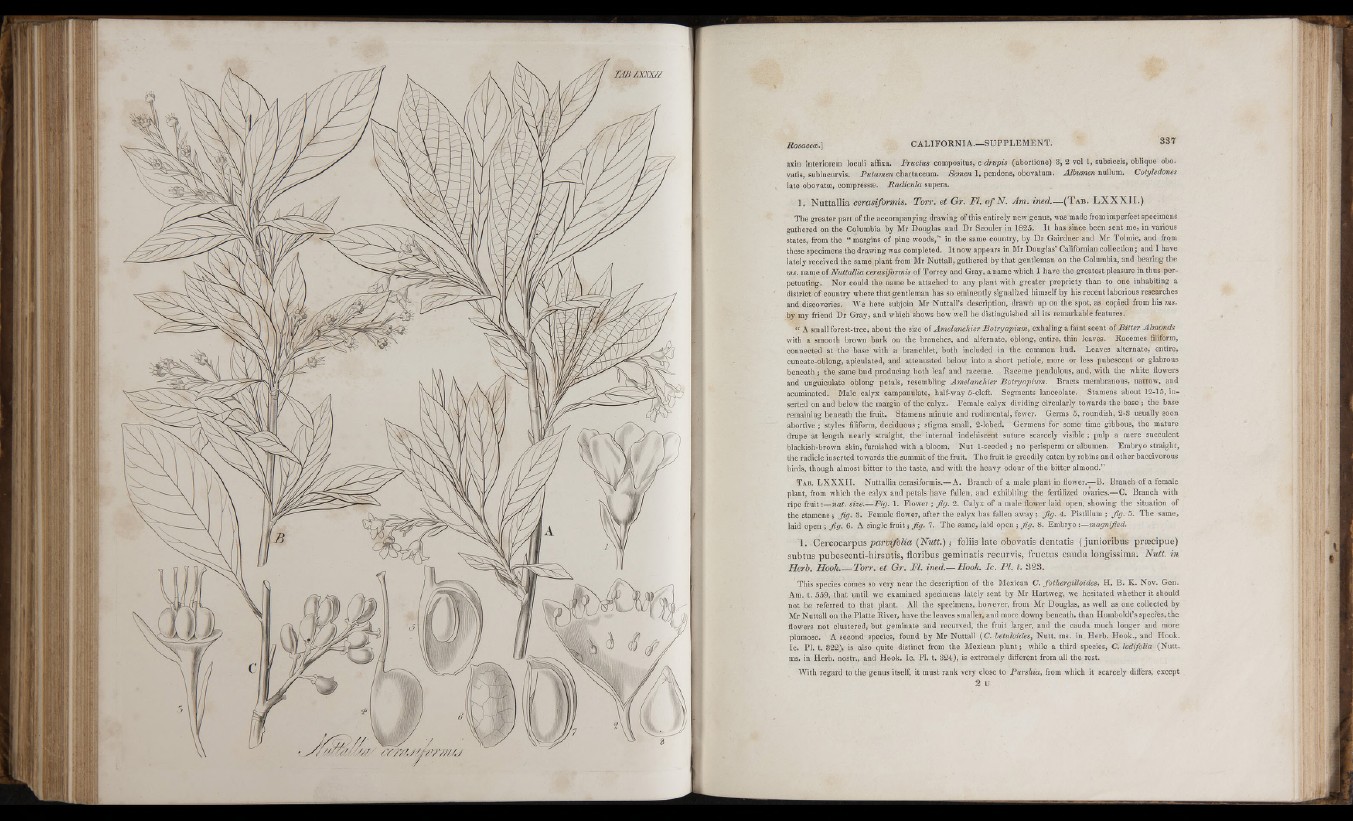
U - ! ,
C A L IF O R N IA .-SU P P L EM E N T . 337
axin interiorem loculi affixa. Fructus compositus, e dritpis (abortione) 3, 2 vel 1, subsiccis, oblique obovatis,
subincurvis. PMiamen chartaceum. 5enze» 1, pendens, obovatum. Albumen nyxWam. Cotyledones
late obovatæ, compressæ. Radicula supera.
1. N u ttailia cerasifonnis. Torr. et Gr. Fl. o /N . Am. ined.— ( T a b . L X X X I I .)
The greater part of the accompanying drawing of this entirely new genus, was made fromimperfect specimens
gathered on the Columbia by Mr Douglas and Dr Scouler in 1825. It has since been sent me, in various
states, from the “ margins of pine woods,” in the same country, by Dr Gairdner and Mr Tolmie, and from
these specimens the drawing was completed. It now appears in Mr Douglas’ Californian collection ; and I have
lately received the same plant from Mr Nuttall, gathered by that gentleman on the Columbia, and bearing the
ms. n&mo of Nuttallia cerasiformis of Torreyand Gray, a name which I have the greatest pleasure in thus perpetuating.
Nor could the name be attached to any plant with greater propriety than to one inhabiting a
district of country where that gentleman has so eminently signalized himself by his receut laborious researches
and discoveries. We here subjoin Mr NuttalTs description, drawn up on the spot, as copied from his ms.
by my friend Dr Gray, and which shows how well he distinguished all its remarkable features.
“ A small forest-tree, about the size of Amelanchier Botryapium, exhaling a faint scent of Bitter Almonds
with a smooth brown bark on the branches, and alternate, oblong, entire, thin leaves. Racemes filiform,
connected at the base with a branchlet, both included in the common bud. Leaves alternate, entire,
cuneate-oblong, apiculated, and attenuated below into a short petiole, more or less pubescent or glabrous
beneath ; the same bud producing both leaf and raceme. Raceme pendulous, and, with the white flowers
and unguiculate oblong petals, resembling Amelanchier Botryapium. Bracts membranous, narrow, and
acuminated. Male calyx campanulate, half-way 5-cleft. Segments lanceolate. Stamens about 12-15, inserted
on and below the margin of the calyx. Female calyx dividing circularly towards the base ; the base
remaining beneath the fruit. Stamens minute and rudimental, fewer. Germs 5, roundish, 2-3 usually soon
abortive ; styles filiform, deciduous ; stigma small, 2-lobed. Germens for some time gibbous, the mature
drupe at length nearly straight, the internal indéhiscent suture scarcely visible ; pulp a mere succulent
blackish-brown skin, furnished with a bloom. Nut 1-seeded ; no perisperm or albumen. Embryo straight,
the radicle inserted towards the summit of the fruit. The fruit is greedily eaten by robins and other baccivorous
birds, though almost bitter to the taste, and with the heavy odour of the bitter almond.”
T a b . LX X X II. Nuttallia cerasiformis.— A. Branch of a male plant in flower.— B. Branch of a female
plant, from which tbe calyx and petals have fallen, and exhibiting the fertilized ovaries.— C. Branch with
ripe fruit:—7ia¿. size.—Fig. 1. Flower ; fig . 2. Calyx of a male flower laid open, showing the situation of
the stamens ; fig . 3. Female flower, after the calyx has fallen away ; fig . 4. Pistillum ; fig . 5. The same,
laid open j fig . 6. A single fruit ; fig . 7. The same, laid open ; fig . 8. Embryo magnified.
I . C e rc o c a rp u s p a r tjj/b im {Nutt.) ¡ foliis l a te o b o v a tis d e n ta tis ( ju n io r ib u s p ræ c ip u e )
s u b tu s p u b e s c e n ti-h irs u tis , flo rib u s g em in a tis re c u rv is , f r u c tu s c a u d a lo n g iss im a . Nutt, in
Herb. Hook.— Torr. et Gr. Fl. ined.—Hook. I c . PI. t. 323.
This species comes so very near the description of the Mexican C. folhergilioides, H. B. K. Nov. Gen.
Am. t. 559, that until we examined specimens lately sent by Mr Hartweg, we hesitated whether it should
not be referred to that plant. All the specimens, however, from Mr Douglas, as we!! as one collected by
Mr Nuttall on the Platte River, have the leaves smaller, and more downy beneath, than Humboldt’s species, the
flowers not clustered, but geminate and recurved, the fruit larger, and tlie cauda much longer and more
plumose. A second species, found by Mr Nuttall (C. beitdoides, Nutt. ms. in Herb. Hook., and Hook.
Ic. PI. t. 322), is also quite distinct from the Mexican plant ; while a third species, C. ledifolia (Nutt,
ms. in Herb, nostr., and Hook. Ic. PI. t. 324), is extremely different from all the rest.
With regard to the genus itself, it must rank very close to Purshia, from which it scarcely differs, except